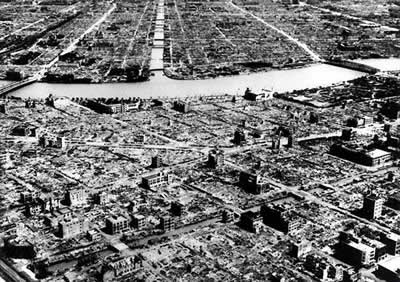More Rubble
Today is the anniversary of the firebombing of Tokyo during World War II, when hundreds of American B-29s incinerated 16-17 square miles of the city and turned 100,000 people — civilians mostly — into ash. Placed along side the sustained Chinese Japanese raids on Chongqing, the German assault on Guernica, and the destruction of Dresden by British and American pilots, the March 1945 raids on Tokyo must surely rank as a low-point in human history.
They are, however, unjustly overlooked, eclipsed by the devastation of Hiroshima and Nagasaki five months later and diminished by the thoroughly merciless theater of the Pacific. Fog of War probably did more to resuscitate the memory of Tokyo’s destruction among Americans, as Robert McNamara reminded us that by any measure these events must be counted as war crimes. In a single night, the United States inflicted a toll of death equal to one quarter of the number of Americans who perished over the course of the entire war.
A French reporter named Robert Guillain described the unthinkable scene:
They set to work at once, sowing the sky with fire. Bursts of light flashed everywhere in the darkness like Christmas trees, lifting their flame high into the night, then fell back to earth in whistling bouquets of jagged flame. Barely quarter of an hour after the raid started, the fire, whipped by the wind, began to scythe its way through the density of that wooden city. As they fell, cylinders scattered a kind of flaming dew that skidded along the roofs, setting fire to everything it splashed, and spreading a wash of dancing flames everywhere. The first version of napalm. Roofs collapsed under the bombs’ impact, and within minutes the frail houses of wood and paper were aflame, lighted from the inside like paper lanterns.
. . . . The inhabitants stayed heroically put as the bombs dropped, faithfully obeying the order that each family defend its own home. But how could they fight the fires with that wind blowing and when a single house might be hit by ten or even more of the bombs, each weighing up to 6.6 pounds, that were raining down by the thousands? As they fell, cylinders scattered a kind of flaming dew that skittered along the roofs, setting fire to everything it splashed and spreading a wash of dancing flames everywhere – the first version of napalm, of dismal fame. The meager defenses of those thousands of amateur firemen – feeble jets of hand-pumped water, wet mats and sand to be thrown on the bombs when one could get close enough to their terrible heat were completely inadequate. Roofs collapsed under the bombs’ impact and within minutes the frail houses of wood and paper were aflame, lighted from the inside like paper lanterns. The hurricane-force wind puffed up great clots of flame and sent burning planks planing through the air to fell people and set fire to what they touched. Flames from a distant cluster of houses would suddenly spring up close at hand, traveling at the speed of a forest fire. Then screaming families abandoned their homes; sometimes the women had already left, carrying their babies and dragging crates or mattresses. Too late: the circle of fire had closed off their street. Sooner or later, everyone was surrounded by fire.

…update by Rob; I wrote a bit about the Tokyo Fire Raid here.


